Read the story of alcohol in art. Drunkenness in Art
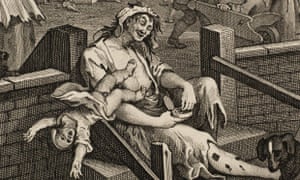 |
| Detail from William Hogarth’s Gin Lane (1751). Photograph: Burstein Collection/Corbis |
From William Hogarth’s Gin Lane to deliberately amateurish photos of Gilbert & George at a bar, the seductions of alcohol are a recurring theme in art. A new exhibition serves Nicholas Lezard with sobering images of drinking and drunks.
Aesthetic considerations, or rather evaluations, need not apply. That’s the point, and consolation, of exhibitions centred on a public theme rather than an artistic one. You get to see the bad as well as the good. Take Tate Britain’s forthcoming display, Art and Alcohol. Cleverly, having neither the wall space nor the budget to whistle for every artwork depicting drunkenness, Tate’s David Blayney Brown has put together a rather modest collection to illustrate not so much the way alcohol affects art or artists, but the way artists use the subject of alcohol to tell a story.
Some artists like telling stories more than others. Robert Braithwaite Martineau’sThe Last Day in the Old Home (1862) may display the faults common to many pre-Raphaelite paintings, all of which may be filed under the broad heading of “mawkishness”, but in the context of this display we are invited to concentrate on the narrative behind the image. The paterfamilias, eyes raised not to heaven or a bright future, but to his tilted glass, with a smile that counts this, and not the welfare of his family, as his delight and his hope; the weeping woman, handing over the keys to the lawyer or estate agent; the young daughter, clutching a doll that itself seems to be weeping; the suit of armour, bespeaking a noble lineage, turned away from his tippling heir, anthropomorphically suggesting disdain.
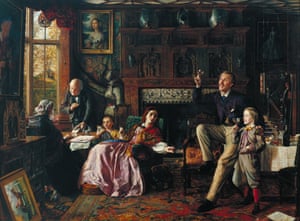 |
| Robert Braithwaite Martineau’s The Last Day in the Old Home (1862). Image: courtesy Tate |
Even the panels over the fireplace tell their story: on the left, a depiction of the Fall; in the centre, the family escutcheon; on the right, a centaur carrying a human child, an allusion (unless I am mistaken) to the outrageous drunken behaviour of the centaurs at a wedding feast (it’s part of the Parthenon frieze, a well-known example of figurative art being used to tell a story, or several stories). There is the auction prospectus in the bottom right-hand corner; the removal man in the hallway, fag in mouth, being handed an axe from above; and most telling and sinister of all, the son, who is lit to suggest that he is the picture’s focus, is himself holding up a glass of wine. Man hands on alcoholism to man. The only hope is that his own eyes are trained not, as yet, on the glass, but slightly above it; although we may have reason to expect those eyes will droop downwards towards it in years to come.
It’s as subtle as any pre-Raphaelite work – which is to say, as a brick – but then we do not turn to such art for subtlety. However, I used the words “in the context of this display” above advisedly. The painting is here, it could be said, almost under false pretences, for the story behind it tells the true one of Colonel John Leslie Toke, a friend of Martineau’s who had to sell the ancestral home after losing all his money gambling, not drinking. There’s a painting of a racehorse in the left foreground to remind us that this is a painting to be read from left to right, its moral made obvious. In which case the alcohol in the father’s and son’s hand now says: this is consolation for the father (who is not yet an alcoholic, his features still being clean-cut and free from ravage, but may well become one); and it is the occasion of a toast – which always aspires to a good future – to the son. So the father is not necessarily “passing his fecklessness to the next generation”, as the rubric next to the painting at Tate Britain attests.
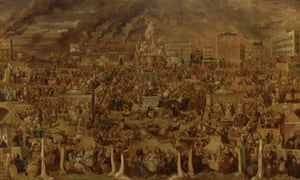 |
| George Cruikshank’s The Worship of Bacchus (1860-2) |
George Cruikshank’s vast pandemonium, The Worship of Bacchus (1860-62), the new display’s cynosure – and very raison d’etre, it being an excuse to take the painting out of storage again after it last appeared in Tate’s Rude Britanniaexhibition of 2010 – is an example of how a work of art can be unsubtle in its message but great art nevertheless. Populated to the point of frenzy by what is, with some exceptions, a seething, crazed mob, it is Hogarth’s Gin Lane squared; almost literally so, if we go by the number of figures depicted. (I count 26 human ones in the Hogarth, while the number in the Cruikshank may be loosely summed up as a multitude.)
If the cynic’s definition of an alcoholic is someone you don’t like who drinks as much as you do, then Cruikshank’s work belies that. As the gallery description notes, Cruikshank stressed that these scenes were taken from real life and he could clearly see, behind the wrecks or maniacs they had become, the faces of the innocent humans they once were. Look, for instance, at the remorseful, humbled figure of the man in the dock for crimes committed while drunk: he is more than an archetype, and reminds us that the rest of the picture is not populated by archetypes, either.
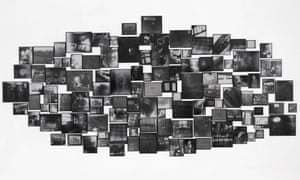 |
| The Evening Before the Morning After (1972) by Gilbert & George. Image: courtesy the artists |
Gilbert & George’s Balls (1972), on the opposite wall of this small gallery, is in dialogue with the Cruikshank. Not as stridently provocative as their later, more celebrated works (or silly, depending on your point of view), G&G’s portrait (or “drinking sculpture”, as they call it) shows “the evening before the morning after”. Consisting of 114 photographs, deliberately amateurish, it represents an evening drinking at the Balls Brothers bar in London’s East End. The artists, hitherto teetotal or nearly so, took up drinking for the sake of their art, or as a project within it, so they could understand, from an artistic point of view, the sensation of drunkenness. (This is something I have tried to explain to many police officers and counsellors, but without any body of work to back me up, it has cut little ice.)
Despite what I said at the beginning, the small number of artworks on show gives you more time to think about them, and those aesthetic considerations start creeping in whether you want them to or not. Confronted by the laziness of Balls,both its concept and its execution, I wondered whether the chief inspiration behind the piece was the desire to use the title Balls. Forgive G&G, you can say: they were much younger then. But it seems odd to place something so callow in plain opposition to the work of an artist with such experience behind him. Cruikshank had been working for half a century and, set against his passion, effort and narrative talent, G&G’s work suffers terribly in comparison. Then again, it does help crystallise what might previously have been fluid views as to whether G&G’s work was ever any good, although that may not have been the display’s intent. (Incidentally, there’s a very good brief talk about the Cruikshank given by the Guardian’s Steve Bell on the Tate website.)
Alcohol is an undeniably tempting subject for art: people do the most outrageous things under its influence, and what kind of observer would not want to depict them, if they had the talent to do so? However, you might leave the display feeling a little short-changed (that is, if it weren’t free to visit). The most bizarre decision is the omission of Hogarth’s Beer Street, which one would have thought the essential companion piece to Gin Lane (1751). If you’re going to have Julius Caesar Ibbetson’s A Married Sailor’s Return next to his An Unmarried Sailor’s Return (c1800) – loving family in the former, drink and ladies of easy virtue in the latter – I wonder what is stopping you from hanging Beer Street next to Gin Lane?
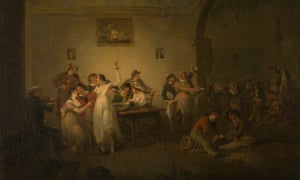 |
| A detail from Julius Caesar Ibbetson’s A Married Sailor’s Return (c1800). Image courtesy of Tate |
The valuable question that Art and Alcohol raises is the capacity and willingness, or unwillingness, of art to moralise; and whether it suffers in its attempt to do so. The problem that artistic depictions of drunkenness are always going to suffer from (a problem that at least Gilbert & George managed to evade in the execution of Balls) is that any artist who relies on the steady hand to paint the work is going to have to lay off the hard stuff while working, and we all know what it’s like to be in the company of the drunk when we are ourselves sober. We tend to purse the lips (and I wonder whether it’s the absence of lip-pursing that has caused Beer Street’s absence). So we’re not getting the whole story here. But at least we’re getting some of it.
Source: theguardian UK



Comments
Post a Comment